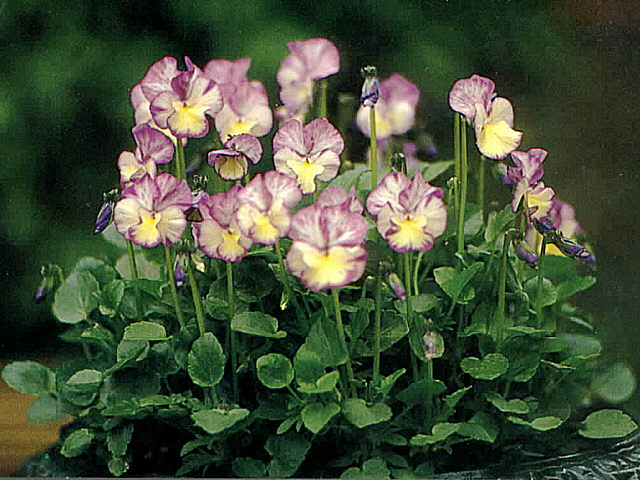| |
 |
Violetta
'Rebecca'
Raised by R.G. Cawthorne
Photo Courtesy J. Snocken, for The National Viola & Pansy
Society
© 2000 All rights reserved |
|
|
In the 1870s, the viola was quite a well-established garden plant, however,
many varieties were still somewhat lank in habit, and the majority of the
blooms showed definite rays. Dr Charles Stuart, residing in Scotland,
embarked upon a breeding programme with the object of producing "rayless"
blooms on plants with a good tufted habit. In 1874 he took pollen from a
variety named 'Blue King' and applied it to the stigma of v.cornuta.
Twelve seedlings were the result. He then applied the pollen of an unnamed
pink variety to each of these seedlings, and it was from this cross that he
found he had not only retained the tufted habit, but also increased the range
of colour. Doubtless, he was a man of great patience, for it was not until
1887 that a totally "rayless" seedling finally appeared. It was
white, with some yellow suffusion in the bottom petal, and a pronounced
fragrance; he named it "Violetta." He chanced to send a box of bloom
to William Robinson, who through his editorship of "The
Garden," held great influence in horticultural matters at that time.
Suitably impressed, and recognizing them to be a distinct new strain, Robinson
featured them in his magazine and so, the first of what was to be known
collectively as Violettas came before a wider and grateful audience.
At the Viola conference held in 1894, it was decided that the time had
come to formally define the essential characteristics of a Violetta. It
was agreed that the flowers of these comparatively miniature types
should be "rayless," oval in shape and between one and one and
a half inches in size; the foliage to be small and compact; the plant
being of dwarf and bushy habit. This definition has stayed with us,
although I am certain that it is not applied with the same rigidity as
in Victorian times.
Very few of the earliest violettas survive. 'Dawn' a pale yellow and
'Buttercup,' a rich warm yellow (originally named Rock Orange) are still
with us. These two are the results of work done by D B. Crane,
and his son H. H. Crane, in the early part of the twentieth
century. As the popularity of the viola declined throughout the middle
part of the century, it was H. H. Crane who worked to keep both interest
and the violetta strain alive. However, it was Richard Cawthorne
who more than anyone made certain that this delightful group did not
suffer extinction. By collecting and breeding he ensured that Violetta's
charms still be enjoyed today. 'Little David' is a cream self that
retains popularity, as does 'Boy Blue,' a mid-blue self. It was 'Boy
Blue' that gave us what is probably the most popular of all 'Rebecca.'
This is a sport of 'Boy Blue,' which shows creamy-white blooms boldly
flaked with rich violet. In my experience everyone who sees this variety
for the first time, wants to have it in their gardens, and because of
its fine bushy habit there is always plenty of good basal cutting
material.
A question remains over the future of Violettas in this new century. I
am certain that a few favourites will survive, but it is to be hoped
that some enthusiast might take on the work of maintaining and improving
this worthy strain.
© 2001 John Snocken, Associate Board Member and Director
The American Violet Society
All Rights Reserved
|
|